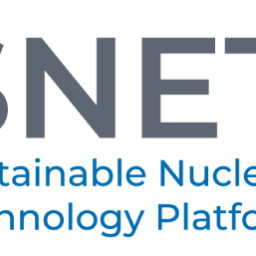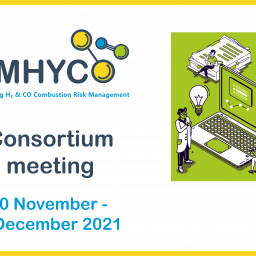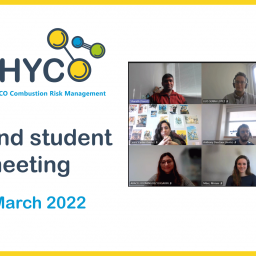
Since the last update, the partners have been busy working on tasks such as analysis, development of 3D models, and selection of severe accident sequences to name a few!

Work Package 1 – Critical review
The concept behind AMHYCO is the need to upgrade the current SAMGs applied in the EU reactor fleet with the most updated understanding on combustible gas behaviour. Part of this knowledge will be generated within the project by articulating, in a concerted way, the nuclear safety tools used worldwide with the most advanced simulation techniques and specific experimentation on scenarios where analytical methodologies are not yet reliable enough.
A critical review of the available literature regarding (1) PAR efficiency under ex-vessel conditions, (2) existing PWR Emergency Operating Procedures (EOPs) and SAMGs regarding containment risk management (3) H2/CO combustion and the available engineering correlations for combustion risk estimation, and (4) equipment and instrumentation surveillance under severe accident conditions has been performed. This review highlighted the need of additional investigation to address the PARs poisoning mechanism and their efficiency in severe accident late phases. Moreover, the lack of knowledge regarding flammability limits and flame acceleration and deflagration-detonation transition criteria has been pointed out. Regarding SAMGs, the review underlines the need to extend the used requirements and procedures to late phases. Concerning safety components and instruments, the review indicates that the “survivability” assessment methodologies are still not consolidated in any official standard.
The corresponding deliverable “Critical assessment of key elements of combustible gases management in containment” has been endorsed by the European Commission in 2022.

Work Package 2 – Selection of severe accident sequences
The main goal of WP2 (Work Package 2) is to characterise scenarios that might threaten containment integrity in Pressurized Water Reactors.
After the first year of AMHYCO, during which the selection criteria for the scenarios and the Figures Of Merit (FOMs) were set, the calculation phase for the three types of PWR reactors addressed within AMHYCO (PWR-KWU, PWR-Western, and VVER) was launched. The results obtained were collected and a specific meeting was held to discuss the main insights gained in terms of the probability of gas combustion events. Preliminarily, the sequences have been mainly chosen according to the gas composition along the in-vessel and ex-vessel phases of the accident. As a result, SBLOCA (20 cm2) and LBLOCA, for PWR-W, and MBLOCA (80 cm2) for PWR-KWU (VVER ones still under discussion). The specific characterisation of these scenarios has been already passed onto WP3, to properly feed test matrices to investigate PAR performance and combustion of H2 and CO mixtures, and to WP4, to benchmarking different approaches of containment analysis and to assessing the effect of different management actions.
The entire database of WP2 calculations has been uploaded in the form of an excel file in the SharePoint of AMHYCO; this database is currently restricted to AMHYCO partners.
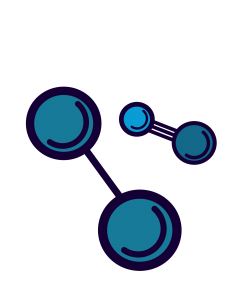
Work Package 3 – Experimental Investigations
The experimental program on PAR operation in a severe accident atmosphere is under performance in the REKO facilities. A database for PAR model validation has been built including relevant experimental data both inside and outside of the AMHYCO project to support the improvement of PAR models. Recommendations for PAR model improvements under the specific late-phase boundary conditions were derived.

Work Package 4 – Full containment analysis
The work in WP4 began in March 2022 with a task to integrate experimental insights, obtained in WP3, on combustion risk and efficiency of late-phase PAR operation into engineering correlations. These can be employed within the subsequent full containment analysis to systematically evaluate containment responses for different mitigation measures using lumped parameter, 3D-GOTHIC, and CFD codes.
In addition, the generic containment database developed in WP2 has been transferred into containment models for generic European PWR plants (KWU-type, Westinghouse/Western-type and VVER-type). Using this database, comprehensive analyses will be carried out for the most penalising sequences, identified within WP2, to provide a basis for the assessment on Severe Accident Management Guidelines (SAMG) in WP5.
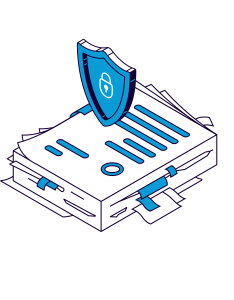
Work Package 5 – Enhancement of Severe Accident Management Guidelines

Work Package 6 – Dissemination, Communication, Education and Training,
The communication and dissemination has continued to keep stakeholders updated on the project’s progress and activities though LinkedIn, the project website and newsletters.
The partners attended numerous events featuring experts from all around the world and all areas of nuclear, safety and combustion. The students working in AMHYCO have even won prizes and got recognition for their great work and results!



